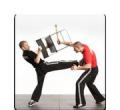Home › Forums › Krav Maga Worldwide Forums › General KM Related Topics › Knife attacks
- This topic has 3 replies, 2 voices, and was last updated 18 years, 10 months ago by
 clfmak.
clfmak.
-
AuthorPosts
-
July 29, 2005 at 3:15 pm #28780
walker
MemberI tried doing some research, but didnt come up with anything, so I figured I would see if any of you know.
What is the percentage of knife attacks that are fatal? I know that in most cases you will probably end up getting cut, but it would be interesting to know, and also probably a good mental advantage to know that you probably wont die if you get cut. That way you may be able to relax a little more in the confrontation, and preform the defense correctly and not just freeze up.July 29, 2005 at 3:40 pm #38906 ryanMember
ryanMemberThe last FBI stats I saw showed 30% to be fatal (as opposed to 10% involving a firearm.) Remember, these are attacks, not threats.
July 29, 2005 at 8:23 pm #38912 clfmakMember
clfmakMemberI used to have a boss who was from South Africa, and he told me that his brother was jumped and stabbed 17-19 times. He lived and went on to be a kickboxer on the international level. I’m guessing all those wounds would make a lot of scars, making him scary-looking while kickboxing.
I read a book recently called \”By the Sword\” and there’s a section about the actual wounds that took place in sword fights- even in the day of duelling there were government people who kept track of fatalities, wounds, and such. I wish I could remember some of the stats. Death was statistically rare, especially after the duel became formalized with sanitized swords with no edges, and rules of combat. Before all of that, many deaths would actually come afterwards, from infection. To prevent this, duellists would refrain from eating, and would make sure to empty their bladder beforehand- to keep food or urine from entering the body cavity. Statistically, the straight sword (epee style) has always been the deadlier weapon rather than the saber (although it was definitely the bloodier), often because of the infection factor of thrusts. Later on, in America, the Bowie knife became known as the deadliest duelling weapon, and many tried to ban it. There is a formal style of duelling still practiced in Germany, where combatants are lightly armored everywhere but the head, and they try to cut each others’ head with saber-like swords- this leaves scars but pretty much never leads to serious injury. If you do a google image search for mensur, you’ll find a lot of really bloody pictures. In modern fencing, occasionally people are stabbed by a tip breaking off and the shaft hits them, sometimes piercing the brain and causing instant death. This may all seem very off topic, but as I see things combat has not changed that much, and swords (especially western duelling swords) are just big knives. I recommend checking the book out, especially the chapter \”Spilled Blood\”. Formal records on this sort of thing go back farther than the ones the US has.
More recently and relevantly, a guy from Black Belt collected a whole lot of stats about how altercations happen. Some stats are relevant: Forty-six percent of the group attacks examined in the Violence Project involved weaponsómost often baseball bats and handguns. Regarding all of the altercations (armed and unarmed) 28 percent of the defenders required medical care, and 7 percent of the aggressors required medical care. This article is good for all people interested in self defense.
http://www.blackbeltmag.com/document_display.cfm?document_id=144&keyword=Violence%20and%20project&summary=1&startsum=1
They have another case study about only knives, but with less oveall data. The results:
-An overhand stab is five times more likely than other stabs to strike the head or face.
-Approximately 97 percent of reverse- grip stabbing attempts succeed in injuring the victim. Approximately 68 percent of those attempts result in an incapacitated victim.
– Virtually all reverse-grip aggressions occur indoors.
-between five and 15 wounds are typical in incidents in which the reverse grip is used.
-Overall, reverse-grip blade and shank uses were nearly twice as deadly as stealthy uses from the natural grip, and 30 times more lethal than leadhand blade deployments. The weapons employed were usually butcher knifes, other fixed-blade knives or pointed tools. Only a few folding knives were used in this manner.
These are all from this useful article:
http://www.blackbeltmag.com/document_display.cfm?document_id=178&keyword=knives&summary=1&startsum=1
That’s what I have to contribute, in order of increasing relevance.August 1, 2005 at 1:20 am #38957 clfmakMember
clfmakMemberI also read an article interviewing some convict who had seen a lot of violence in prison. Relevant notes- he said that the most common target was under the arm, piercing the lung. He said that when pierced here, they would instantly collapse, but with other spots like the kidney or throat, they might still be able to fight back. To prevent this, inmates would wear magazines under their clothes like armor.
-
AuthorPosts
- You must be logged in to reply to this topic.



